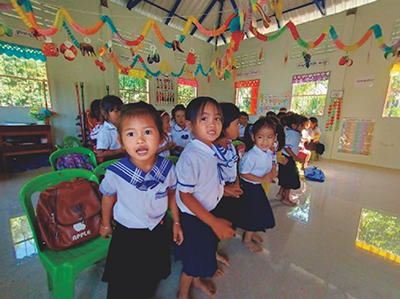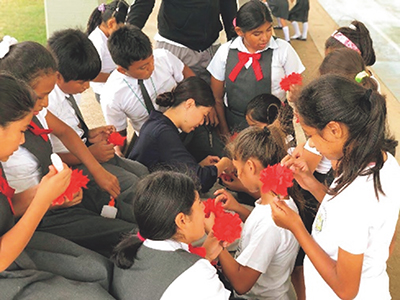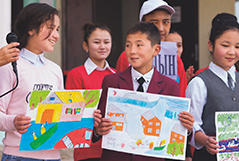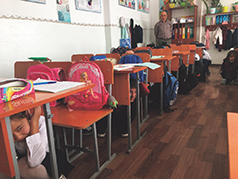(3) Quality Education for All
There are as many as approximately 59 million children who cannot go to elementary school worldwide.
When including secondary school, it is estimated that there are approximately 258 million out-of-school children (17% of the total) Note 32. In particular, the percentage of children who cannot go to school has been increasing since 2000 in Sub-Saharan Africa. Furthermore, as the World Bank points out in the World Development Report (2018), the learning crisis has also become a major problem, in which even the children who go to school cannot perform basic reading, writing, and arithmetic skills. Moreover, many children have been impacted by school closures due to the spread of COVID-19. Above all, children with disabilities, children of minority ethnic groups or those in disadvantaged communities, refugee and displaced children, and those living in remote areas are at the greatest risk of being left behind, and there are further concerns surrounding the impact of school closures on malnutrition, early marriage, and gender inequality. To address this situation, new methods of learning, including remote learning, are being explored around the world, and Japan is also providing support using its own expertise and technology for online learning (see “Master Techniques from Japan to the World”). It is necessary to provide opportunities for education and vocational training to young people that respond to social changes and technological innovation, and foster human resources who can create innovation toward resolving global issues.
Goal 4 of the SDGs has been set up to “Ensure inclusive and equitable quality education and promote lifelong learning opportunities for all.” The international community formulated the “Education 2030 Framework for Action”* in 2015, with the aim of achieving this goal.
In 2019, Japan compiled the G20 Initiative on Human Capital Investment for Sustainable Development: Quality Education to Create an Inclusive, Resilient, and Innovative Society, as the G20 Presidency. The G20 Osaka Leaders’ Declaration reaffirms the commitment to promote quality education that is inclusive and fair for all people through human capital investment. In addition, in his speech to the General Debate of the 74th session of the UN General Assembly in September 2019, then Prime Minister Abe mentioned the promotion of inclusive, quality education for all girls and women and emphasized that “the essence of Japan’s international engagement can be found in the fact that we earnestly value education.”
●Japan’s Efforts

Children learning at a kindergarten in Kampot Province, Cambodia, built through Grant Assistance for Grass-Roots Human Security Projects (Photo: Planète Enfants & Développement)
Japan has traditionally placed importance on assistance in the field of education as an essential area for promoting human security and has been providing developing countries with a broad range of support, including the enhancement of basic education*, higher education, and vocational training.
As one of the G20 Presidency’s initiatives, Japan announced its “Education x Innovation” initiative to support at least approximately nine million children and young people during the three-year period between 2019 and 2021. In order to allow all children to complete quality elementary and secondary education by 2030, it is essential to encourage innovation to accelerate assistance. Through this initiative, Japan will further strengthen support for education that fosters basic knowledge, STEM education Note 33, development of e-learning, and more.
At TICAD7 in August 2019, as initiatives for education and human resources development in Africa, Japan announced its intention to provide quality education to three million children through measures such as science and mathematics education and improvement of the learning environment, as well as develop 5,000 highly-skilled people for STI through assistance for the Egypt-Japan University of Science and Technology (E-JUST)* and Jomo Kenyatta University of Agriculture and Technology in Kenya. It was also announced that E-JUST would receive 150 African students, and 28 African students were newly admitted in 2020.
Also, Japan contributed a total of approximately $30.58 million from 2008 to 2020 to the Global Partnership for Education (GPE)*, an international fund specialized in education. In partner countries that received support through GPE, the number of children supported by the fund between 2015 and 2018 was approximately 25 million, and three out of four have finished elementary education.
Moreover, with a focus on Niger and other West African countries, Japan has been implementing the “School for All” project since 2004, which aims to build relationships of trust between schools, parents and guardians, and local residents, as well as improve the education environment for children. In cooperation with the World Bank, the GPE, and others, Japan is spreading the project throughout the targeted African countries.
In addition, in Egypt, the introduction of Japanese-style education at local schools has been promoted since February 2017 under the Egypt-Japan Education Partnership (EJEP) announced in 2016. 41 “Egypt-Japan Schools” that introduced this Japanese-style education were opened by October 2020. In Egypt, the “Tokkatsu-plus” model for Japanese-style education has been introduced, and primary and junior high students at above-mentioned schools are engaged in special activities, such as cleaning, chore duties, and class meetings, as the core for holistic education that aims to build harmonious character, including sensitivity and morality. Japan also cooperates in human resources development in Egypt, providing support related to learning through playing at kindergartens for pre-school children and management needed to conduct special activities for school administrators.
Furthermore, in order to encourage the development of education and improvement of its quality in the Asia-Pacific region, by contributing to a funds-in-trust within the United Nations Educational, Scientific and Cultural Organization (UNESCO), Japan is providing support for organizing the Asia-Pacific Meeting on Education 2030 (APMED2030) annually, a forum for discussing progress in the achievement of Goal 4 (Education) of the SDGs. Japan also supports initiatives toward the achievement of Goal 4 in the Asia-Pacific region including through the quality improvement of elementary, secondary, and higher education, enrichment of early childhood education, spread of non-formal education, and increasing the teaching capacity of teachers. Moreover, Japan supports human resources development in developing countries by engaging in efforts to strengthen networking among higher education institutions between Japan and ASEAN, collaborating with the industrial sector, participating in joint research projects with neighboring countries, accepting international students to Japanese institutions of higher education and other institutions in accordance with the “300,000 International Students Plan,” and a wide range of other measures.
... Promoting Education for Sustainable Development (ESD)

A JOCV for Nikkei Communities conducting an activity at the San Juan School (a Nikkei school) in the San Juan settlement, Bolivia (Photo: JICA)
“Education for Sustainable Development*: Towards achieving the SDGs (ESD for 2030)” is a new international implementation framework from 2020 to 2030 that began on January 1, 2020 with UNESCO as the leading organization. It was adopted at the 40th Session of the General Conference of UNESCO in November 2019 and the 74th Session of the UN General Assembly in December of the same year as the successor program to the “UN Decade of ESD (UNDESD)” program (2005 to 2014) and the “Global Action Programme (GAP) on ESD” (2015 to 2019). ESD is education to contribute to the realization of all SDGs by fostering the leadership needed to build a sustainable society, and as an advocate of ESD, Japan continues to engage in the promotion of ESD as well as play a significant role in its global spread and deepening through contributions to the funds-in-trust in UNESCO. In addition, through the funds-in-trust, Japan is actively promoting ESD by implementing the “UNESCO-Japan Prize on ESD” together with UNESCO, which awards individuals and organizations that conduct excellent initiatives toward putting ESD into practice, and has been presented to 15 organizations to date (see “Stories from the Field” for the voices of Japanese personnel working in UNESCO).
Kyrgyz RepublicPublic nomination
Project for Supporting Safe School Programme
Grant Aid (Partnership with UNICEF) (March 2017 – March 2020)

Children in the Kyrgyz Republic presenting drawings on the theme of disaster risk reduction (Photo: UNICEF Kyrgyzstan office)

Children at a model school participating in an evacuation drill assuming an earthquake (Photo: UNICEF Kyrgyzstan office)
The Kyrgyz Republic, a mountainous landlocked country located in the northeastern part of Central Asia, is prone to various natural disasters such as earthquakes, floods, and landslides, and the situation has worsened due to climate change in recent years. According to a survey conducted in 2014, approximately 85% of educational facilities were considered to be unsafe and could be affected by natural disasters. Thus, the safety of schools, which is directly linked to safety of children, has been a major issue for people in the Kyrgyz Republic.
In partnership with UNICEF, Japan supported a project to ensure school safety and strengthen disaster risk reduction systems, which would raise awareness of disaster risk reduction among teachers and children. Specifically, a survey was conducted regarding the safety of ten model schools for disaster risk reduction, and alarm systems, emergency exit signs, and anti-fire metal fire doors were installed in schools that had previously been ill-equipped with disaster risk reduction equipment. In addition, evacuation drills and disaster risk reduction education were conducted for 65,000 students and 3,000 teachers in 121 schools, as well as for local government officials, to enable them to take actions
to save their lives in the event of disasters.
The principal of one of the model schools said, “We utilize what we have learned to conduct evacuation drills twice a year. Thanks to the support, the children’s awareness of disaster risk reduction has increased.” Moreover, the project has contributed significantly to raising awareness of disaster risk reduction nationwide by creating a training video for teachers on disaster risk reduction in schools, as well as five educational animations on climate change and disaster risk reduction using popular Kyrgyz characters which are widely broadcast on national television.
In implementing the project, the UNICEF Kyrgyzstan office emphasized the importance of utilizing Japan’s knowledge and experience on disaster risk reduction. In addition, through cooperation and collaboration with the Government of the Kyrgyz Republic, it promoted the use of disaster risk analysis at the local government level and institutionalization of child-sensitive disaster risk reduction initiatives to enhance disaster risk reduction systems in schools. Furthermore, a study tour was conducted in Japan to learn about disaster risk reduction education policies and initiatives for government officials in charge of disaster risk reduction, which contributed to the capacity development of these officials.
- *Education 2030 Framework for Action
- The Education 2030 Framework for Action succeeds the EFA Dakar Framework for Action aimed at achieving education for all, adopted at the World Education Forum in Dakar, Senegal in 2000. It was adopted at the Education 2030 High-Level Meeting, which was held to coincide with the UNESCO General Conference in 2015.
- *Basic education
- The educational activities designed to enable individuals to acquire the knowledge, values, and skills necessary to live. It mainly refers to elementary education, lower secondary education (equivalent to Japanese junior high schools), pre-school education, and adult literacy education.
- *Egypt-Japan University of Science and Technology (E-JUST)
- A university that was established based on an agreement (bilateral agreement) between the Government of Japan and the Government of the Arab Republic of Egypt to establish the Egypt-Japan University of Science and Technology, concluded in 2009. Based on the agreement, Japan provides technical support, including for improving education and research materials, while cooperating with universities in Japan, in order to enable E-JUST to operate as a university based on the concept of providing graduate school, research-centered, pragmatic, and international-standard education for a small number of students, which is characteristic of Japanese-style engineering education. Japan is currently implementing technical support aimed at establishing E-JUST’s foundation as a top-level research university in Egypt in order for E-JUST to produce human resources in the field of industry and science and technology who will contribute to the development of the higher education sector and industries in the Middle East and Africa.
- *Global Partnership for Education (GPE)
- GPE refers to an international partnership established under the leadership of the World Bank in 2002, which supports the education sector in developing countries. Its members include developing countries, donor countries and organizations, civil society, and private-sector corporations and foundations. It was renamed as GPE from Fast Track Initiative (FTI) in 2011.
- *Education for Sustainable Development (ESD)
- ESD refers to education that fosters builders of sustainable societies. “Sustainable development” means development that “meets the needs of the future generations while also meeting the needs of the present generation.” In order to build such a society, it is necessary to perceive a variety of challenges in contemporary society, such as the environment, poverty, human rights, peace, and development, as one’s own problems and then to work to find solutions for them. For that purpose, ESD puts importance on creating new values and actions. ESD was affirmed as being the key for achieving all the SDGs in the resolutions of the 72nd Session of the UN General Assembly in 2017. This was also reaffirmed in the “ESD for 2030” from 2020, which was adopted by a resolution of the 74th Session of the UN General Assembly in 2019.
- Note 32: From pages 6 and 354 of the “Global Education Monitoring Report 2020.” https://unesdoc.unesco.org/ark:/48223/pf0000373718
- Note 33: STEM is an acronym for science, technology, engineering, and mathematics, and refers to these four educational fields.
